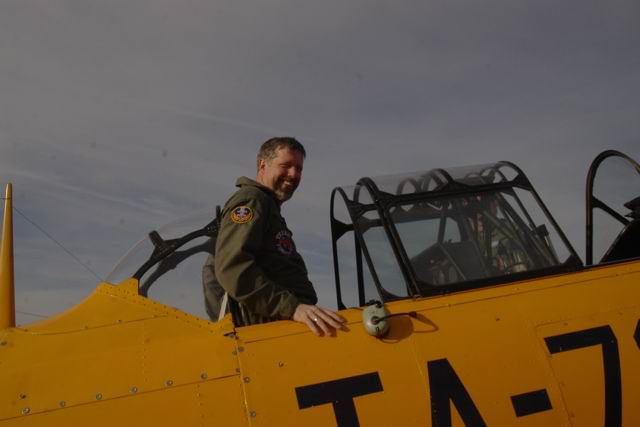|
|
|||||||||||||
|
helping
architects and engineers deliver superior design documents |
|||||||||||||
|
Guastavino ProjectsVertical Access first gained exposure to Guastavino tile while inspecting the interior vaults at St. Thomas Church in New York City in 1996. Almost ten years and half a dozen Guastavino projects later, Vertical Access has developed an expertise in the inspection and evaluation of this remarkable structural and decorative material.
Guastavino tile has experienced a resurgence of interest in the past five to ten years, owing to the work and forsight of three individuals. The construction technique was ultimately made available to preservationists through the work of George Collins, a long-time faculty member in the Art History and Archeology Department at Columbia University. Having followed the rise and fall of the Guastavino Company, when he learned of the company's impending dissolution, Collins facilitated the donation of the archive to the Avery Fine Arts Library at Columbia. Since Collins' death in the late 1980's, Janet Parks and Alan Neumann were instrumental in cataloging all the components of the archive, which culminated in a gallery show and book: The Old World Builds the New. APTI (The Association for Preservation Technology International) and NYLC (New York Landmarks Conservancy) increased exposure when it presented a one-day symposium in 1999 on the subject of Guastavino. The proceedings of this symposium, along with reproductions of the Guastavino patents are collected in a dedicated issue of the APTI Bulletin.
Another recent VA project was the sounding at St. Paul's Chapel on Columbia University's campus. VA was brought on by Robert Silman Associates to aid in sounding the Guastavino from a DENKA lift. This lift has a 90 foot vertical reach with the 10 foot jib boom extended and allowed VA to reach every area of the Guastavino. The structural Guastavino was found to be in excellent condition, with problems only in the small Maltese cross tiles lining the windows. These ornamental tiles were applied over the structural Guastavino tiles, and had delaminated. Highlighting Vertical Access exposure to Guastavino projects, Kent Diebolt gave a presentation at Les Estructures Historiques...Substiticio o Conservacio in Barcelona in December. Chuck DiSanto of Walter Melvin Associates also spoke on the Queensboro Bridge project. Also, an in-house research pilot study of using ultrasonic frequency response for the evaluation of delaminated Guastavino tiles has shown very positive initial results. Kelly Streeter presented the findings of this pilot study at the APT northeast chapter meeting in New York in March. Funding is currently being sought to continue this research. Upcoming Guastavino projects for Vertical Access include the Oyster Bar and the Federal Reserve Bank, both in New York City, and the Plymouth Monument in Massachusetts.-Kelly Streeter, Photos by Jon Reis RESOURCES:
Technical Highlight: Ground Penetrating Radar
Ground penetrating radar, also referred to as georadar, earth sounding radar, or surface penetrating radar, has been an emerging technology since its commercialization in the 1970's. It is used in a wide range of applications including utility detection, forensic investigation, archeology, and the inspection of concrete, bridges, highways, architectural facades, rail beds, and airports. GPR can provide valuable information about the subsurface of the ground or a building component by nondestructively revealing voids, layers, and the presence of other materials such as metal or plastic. Radar works well for examining any material with low electrical conductivity. Electromagnetic energy travels through substances at velocities determined by the dielectric of a material. Reflections of this energy are caused by changes in dielectric properties of materials. As the signal travels through a medium like a concrete slab, materials such as steel can cause a reflection due to the difference in dielectric between the two substances. This reflection is visualized as a hyperbola on the time domain (Figure 1). A series of survey lines in two perpendicular directions can be used to create a grid. This data can be analyzed to create depth slices (Figure 2) or a 3D interpretation of targets at various depths in a scanned area (Figure 3).
Equipment for performing a GPR survey includes a radar control unit, antenna, and data storage device. The control unit sends a trigger pulse to the transmitter in the antenna which is transformed into an electromagnetic pulse. At the same time, the storage device is alerted to start recording data. The size, shape, and configuration of the transmitting antenna determine the frequency, bandwidth, and beamwidth of the signals emitted. After transmitting the pulse, the antenna switches to receive mode, and energy reflected from changes in dielectric is picked up and passed back to the control unit, which converts the signal to digital form. Individual radar pulses are generated and reflections are recorded continuously at a rate chosen by the user, but typically 50 to 100 pulses are recorded each second. The subsequent series of reflected waveforms is analyzed by the equipment operator, ranging from hyperbolic shapes for pipe-like targets to planar reflections from larger anomalies. Alternatively, data may be stored on the processor for later analysis in the office with post processing software. Ground penetrating radar is an effective tool for looking at what may be beneath a surface nondestructively. This technology could aid in determining the structural configuration of existing structures and finding voids or fractures in facades. In many cases, the use of nondestructive techniques is the most cost effective means of acquiring desired data about a structure. -Shan Wo of Atkinson-Noland and Associates, Inc.
Figure 3
| ||||||||||||
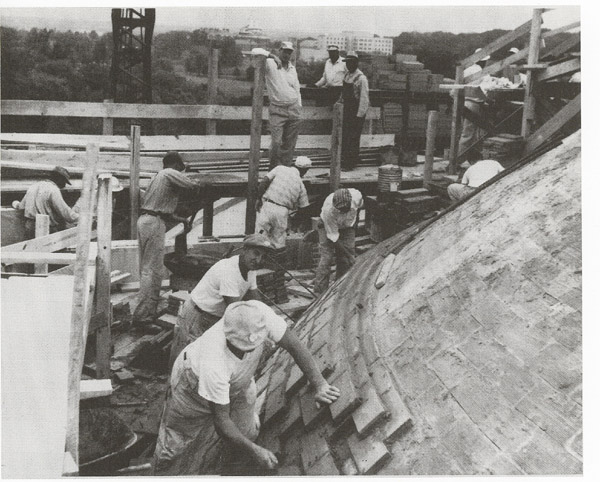 Rafael Guastavino adapted a form of the timbrel (or
Catalan) vault in which thin bricks or tiles are adhered together with a
quick-drying mortar to create a laminated, thin shell-type structure. After
earning a reputation in his native Spain building
factories, mills and elaborate homes, Rafael Guastavino left for the United States in 1881.
Eventually endorsed by the
architectural community here, Guastavino contributed to
more that 1000 historically significant buildings in the United States.
Rafael Guastavino adapted a form of the timbrel (or
Catalan) vault in which thin bricks or tiles are adhered together with a
quick-drying mortar to create a laminated, thin shell-type structure. After
earning a reputation in his native Spain building
factories, mills and elaborate homes, Rafael Guastavino left for the United States in 1881.
Eventually endorsed by the
architectural community here, Guastavino contributed to
more that 1000 historically significant buildings in the United States.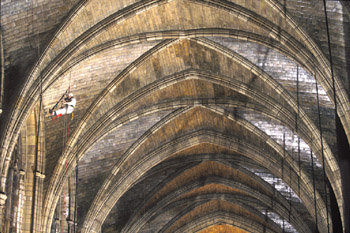 When we first worked with
St. Thomas Church, it had a fixed budget to spend
on renovation and wanted to ensure that the interior of the Guastavino
vaults were sound to preserve funds for the higher-priority exterior renovation work.
A close visual inspection and live-feed
video were employed to investigate four suspect areas. In the end,
Vertical Access was able to complete the inspection for about 15% of the
cost for scaffolding to be built for the same purpose.
When we first worked with
St. Thomas Church, it had a fixed budget to spend
on renovation and wanted to ensure that the interior of the Guastavino
vaults were sound to preserve funds for the higher-priority exterior renovation work.
A close visual inspection and live-feed
video were employed to investigate four suspect areas. In the end,
Vertical Access was able to complete the inspection for about 15% of the
cost for scaffolding to be built for the same purpose.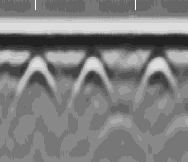
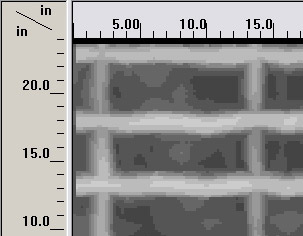
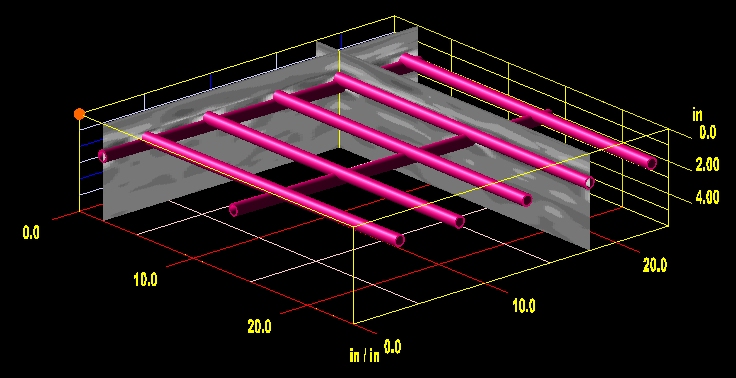
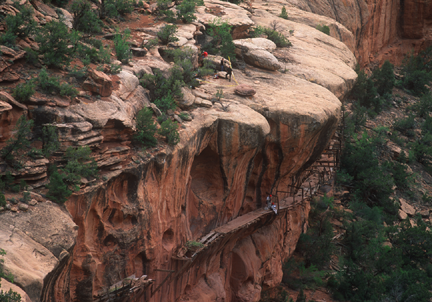 Since
Vertical Access's involvement with the Hanging Flume Project in April of
2004, the 120 year old structure has had much exposure in the historic
preservation community both at home, in Colorado, and abroad. Ron
Anthony of Anthony & Associates gave a talk to the Denver Mining
Club in late January. Ron and Kent Diebolt of Vertical Access co-authored and presented at The Colorado Preservation Inc.
(CPI) in early
February. Justin Spivey of
Since
Vertical Access's involvement with the Hanging Flume Project in April of
2004, the 120 year old structure has had much exposure in the historic
preservation community both at home, in Colorado, and abroad. Ron
Anthony of Anthony & Associates gave a talk to the Denver Mining
Club in late January. Ron and Kent Diebolt of Vertical Access co-authored and presented at The Colorado Preservation Inc.
(CPI) in early
February. Justin Spivey of 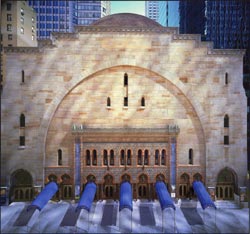 The ornate
New York City Center building was originally constructed by the
Shriners with faux-Moorish details by the architects, Harry P.
Knowles and Clinton & Russell. Nearly turned into a
parking garage in the 1940s, the building was rescued by Mayor
LaGuardia, who opened it as the city's first performing arts center
in 1943.
The ornate
New York City Center building was originally constructed by the
Shriners with faux-Moorish details by the architects, Harry P.
Knowles and Clinton & Russell. Nearly turned into a
parking garage in the 1940s, the building was rescued by Mayor
LaGuardia, who opened it as the city's first performing arts center
in 1943.
 After
the recent mid-year APT Board of Directors meeting at the Cranbrook
Institute, near Detroit, Past President Kent Diebolt and Director Steve
Kelley took turns flying with "ace" Staley, former treasurer
and secretary of APT.
After
the recent mid-year APT Board of Directors meeting at the Cranbrook
Institute, near Detroit, Past President Kent Diebolt and Director Steve
Kelley took turns flying with "ace" Staley, former treasurer
and secretary of APT.
